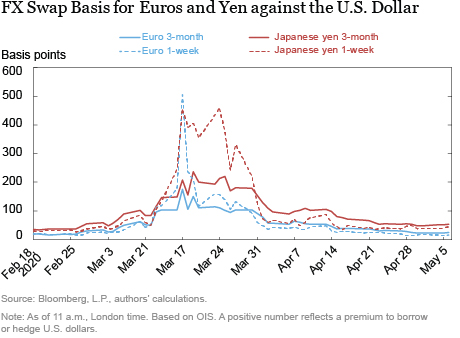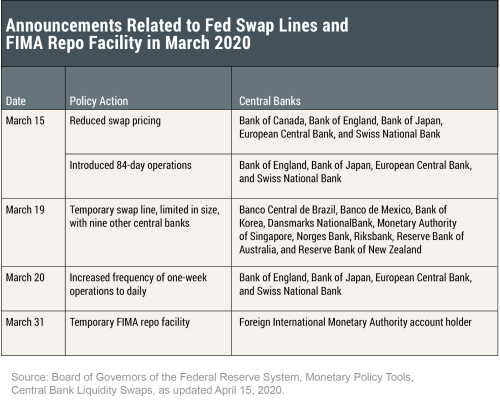In March 2020, the Federal Open Market Committee (FOMC) made changes to its swap line facilities with foreign central banks to enhance the provision of dollars to global funding markets. Because the dollar has important roles in international trade and financial markets, reducing these strains helps facilitate the supply of credit to households and businesses, both domestically and abroad. This post summarizes the changes made to central bank swap lines and shows when these changes were effective at bringing down dollar funding strains abroad.
Strains in Overseas Dollar Funding Markets and the Fed’s Response
Financial and nonfinancial institutions around the world transact in dollars. In early to mid-March 2020, amid extreme volatility across financial markets triggered by the coronavirus pandemic, overseas dollar funding markets were severely disrupted. The foreign exchange swap basis spread is a valuable indicator of conditions in U.S. dollar funding markets. The basis spread is the premium paid by international institutions to obtain U.S. dollars in the foreign exchange swap market for a specified period of time. Our calculations use one-week and three-month tenors of the funds, and use the overnight indexed swap rates (OIS) as the interest rates.
The chart below shows that the basis spread increased, indicating that conditions in global U.S. dollar funding markets deteriorated at the end of February for term transactions and became particularly strained in mid-March for short tenor transactions. Through the week of March 16th, offshore funding market conditions further worsened, as did conditions in other U.S. financial markets.

The FOMC engaged in a series of coordinated actions with foreign central banks to directly address this form of distress (see table below). First, for already existing standing swap lines with five central banks (SSCBs)—the Bank of Canada, Bank of England, European Central Bank, Bank of Japan, and Swiss National Bank—the cost of funds was reduced, longer term (eighty-four-day) swaps were added to existing short term (seven-day) swaps, and the frequency of auctions for short-term funds was increased from being weekly to being daily. In addition, the FOMC re-introduced a set of nine other temporary swap lines with central banks (TSCBs). Finally, a new temporary repo facility for foreign and international monetary authorities (FIMA repo) was established, with FIMA account holders able to temporarily exchange their U.S. Treasury securities held with the System Open Market Account of the Federal Reserve for U.S. dollars, which can then be made available to institutions in their jurisdictions. The central bank swap lines reach key financial centers worldwide and parents of many foreign banking organizations (FBOs) operating in the United States.

Did Fed Swap Lines Alleviate Global Funding Market Strains?
We explore this issue using daily data on FX swap basis spreads for twenty-three currencies during the period February 16 through April 9, 2020. We evaluate the differential impact on FX swap basis spreads of currencies directly targeted by a swap line announcement relative to those of currencies not directly covered by the specific announcement. There were four announcements: (1) the announcement for the SSCBs on March 15, (2) the March 19 announcement for TSCBs, (3) the announcement of daily auctions for the SSCBs, and (4) the announcement of the FIMA repo facility. The announcement window includes the day of, and, in some cases, the day following the announcement. The basis spread changes over this window are compared with the average spread during the two days prior to the announcement.
The results show that, relative to other currencies, those currencies with announcements related to standing and temporary swap lines did not have significantly narrower FX swap basis spreads on and after announcement dates. By contrast, the announcement of the increased frequency of one-week U.S. dollar operations lowered the rate of increase in the FX swap basis spreads for currency pairs of countries with the standing swap lines, as compared to the changes observed in FX swap basis spreads of other currency pairs. In other words, this announcement improved market conditions on the announcement day, relative to conditions over the prior two days.
Did the actual settlement of funds from U.S. dollar operations, whether at the one-week tenor or at the eighty-four-day tenor, have materially different effects on the FX swap basis spreads of currency pairs of the standing swap central banks versus those of all other currencies? After controlling for the effects of concurrent equity market volatility, we find that only the settlements of daily one-week auctions on one-week FX swap basis spreads improved market conditions. In contrast, settlements of one-week and eighty-four-day operations were not associated with significant improvements in market functioning as initially term liquidity obtained by banks was only partially channeled beyond the banking system.
Considerations and Looking Ahead
This post corroborates market participants’ feedback that the swap lines have been an important factor helping to improve market conditions and expand access to dollar liquidity during the period of peak strains in global U.S. dollar funding markets. Nevertheless, other decisive FOMC actions taken in March to support market functioning and the flow of credit in the United States may also have helped ease conditions in global dollar funding markets.
Despite these actions, longer-dated FX swap basis spreads remained relatively wide for some time after the implementation of changes to the swap lines. It could be that the foreign banks that primarily bid at U.S. dollar operations of their central banks borrowed dollars to meet their own funding needs—including those of their U.S. branches and for precautionary purposes. It might also be the case that foreign banks did not lend in sufficient amounts to U.S. dollar borrowers in their home jurisdictions. Indeed, in early April, market participants continued to note that foreign banks, similar to U.S. banks, were reluctant to provide dollar intermediation, especially for term funding, given uncertainty over the duration of the COVID-19 pandemic. Meanwhile, the swap lines continue to serve as an important liquidity backstop for supporting the global dollar funding markets.

Nicola Cetorelli is a vice president in the Federal Reserve Bank of New York’s Research and Statistics Group.

Linda Goldberg is a senior vice president in the Bank’s Research and Statistics Group.

Fabiola Ravazzolo is an officer in the Bank’s Markets Group.
How to cite this post:
Nicola Cetorelli, Linda S. Goldberg, and Fabiola Ravazzolo, “Have the Fed Swap Lines Reduced Dollar Funding Strains during the COVID-19 Outbreak?,” Federal Reserve Bank of New York Liberty Street Economics , May 22, 2020, https://libertystreeteconomics.newyorkfed.org/2020/05/have-fed-swap-lines-reduced-dollar-funding-strains-during-the-covid-19-outbreak.html.
Disclaimer
The views expressed in this post are those of the authors and do not necessarily reflect the position of the Federal Reserve Bank of New York or the Federal Reserve System. Any errors or omissions are the responsibility of the authors.











 RSS Feed
RSS Feed Follow Liberty Street Economics
Follow Liberty Street Economics
For now the Fed actions helped the Dollar Funding but not for long project there is going to be a major issue on Liquidity and Dollar Funding coming out of Europe. European Banks have a lot of illiquid and Risk Assets on their books which are underwater. It is going to be interesting watch how the FED and Central Banks respond to Debt Deflation.